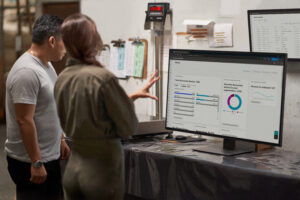
The era of AI: Transformative AI solutions powering the energy and resources industry
Energy and resources companies face the tremendous challenge of providing secure and reliable energy for 8.1 billion people and growing while moving toward a carbon-free world. Under pressure to adapt quickly to changing demands, regulations, and technologies, the energy sector is turning to AI to accelerate the energy transition and operate more efficiently, safely, and sustainably.
Today’s headlines are dominated by news about AI, from the latest discussions about Microsoft Copilot to ways that AI paves the way for a sustainable energy future. The use of AI is increasing the availability and efficiency of renewable energy sources such as solar, wind, hydroelectric, and biomass which now account for approximately 30 percent of electricity generated worldwide1
The World Economic Forum underscores the role AI plays in the energy transition and estimates that every 1 percent additional efficiency in demand creates USD1.3 trillion in value between 2020 and 2050 due to reduced investment needs.2
Microsoft partners with organizations across the energy and resources sector on solutions to drive workforce transformation, improve operational efficiencies, accelerate net-zero, and increase energy innovation and growth opportunities. We work with customers and partners on:
- Enhancing safety and security by using facial recognition, anomaly detection, and robotics to prevent accidents, protect workers, and secure facilities.
- Increasing operational and energy efficiency by using data analytics, machine learning, and the Internet of Things (IoT) to optimize supply chains, monitor and control assets, forecast demand, and balance power grids.
- Curbing greenhouse gas emissions by leveraging computer vision, natural language processing, and deep learning to detect leaks, monitor flaring, and track carbon footprints.
- Improving customer service and engagement through chatbots, recommender systems, and sentiment analysis to provide personalized experiences, offers, and feedback.
Leveraging AI to accelerate the energy transition
Our customers in power and utilities, oil and gas, and mining are transforming their workforce and operations to achieve more with less. These innovators are using digital technologies, data analytics, and automation to improve efficiency, safety, and sustainability. Investments include upskilling their employees, fostering innovation, and collaborating with Microsoft to create value for their customers and stakeholders.
Several industry leaders are at the forefront of leveraging data and AI to accelerate the energy transition, including:
- Ontario Power Generation (OPG) teamed with Microsoft to develop an AI-powered chatbot for employees called ChatOPG. The chatbot is designed to provide information, answer questions, and act as a personal assistant at work. Adopting AI technology has helped OPG drive operational efficiencies by improving productivity, safety, and performance among employees.
- Global mining company BHP is accelerating time to value with Microsoft AI and machine learning, using real-time plant data from the copper concentrators and Microsoft Azure Machine Learning to make hourly predictions. These predictions are then used to create machine learning–assisted recommendations for its Escondida operations team. As grade declines at existing mines and fewer new copper deposit discoveries are made, next-generation technologies like AI, machine learning, and data analytics will be used to unlock more production and value from our existing mines to help meet the increasing demand for copper and other minerals to support batteries and new energy generation.
- Boliden is taking advantage of Azure to bring scalability and flexibility to its mining operations, combine cloud computing power, and work locally with mobile devices. Teams get real-time updates using the Boliden camera network without losing valuable time manually watching video streams. Site managers, inspectors, and analysts now get a deeper view of site performance and can focus on business development activities.
- To replace some of their manual processes, E.ON introduced virtual inspections of power lines with drone images and AI. Together with their three distribution system operators, they developed their own virtual inspection solution using Microsoft Azure data and AI services. Drones are used to take pictures, and AI analyzes the images, sorts them, and evaluates them to make the maintenance process safer and more efficient.
- Using an AI and machine learning solution built on Azure paired with IoT technology, Shell automatically identifies safety hazards and alerts service champions to quickly respond to and eliminate potential problems. In addition to protecting lives, having fewer accidents reduces operating costs and environmental impact.
- Snam is using Microsoft AI and IoT technology to support data collection and strengthen security across its European pipeline network. In addition, the organization is using Azure Machine Learning for a deeper understanding of key equipment to improve proactive maintenance activities and boost energy efficiency.
Partnering on AI innovation
Our extensive, global partner ecosystem is fundamental to accelerating innovation across the energy sector. While technology is an enabler, collaboration is the true foundation for addressing the world’s complex energy challenges. Microsoft is actively working with partners SLB, Cognite, Bentley, and many others to accelerate ideation and the development and deployment of AI-driven, sustainable energy solutions. You can find out more about our partnerships in my June blog.
- SLB was named Energy and Resources Partner of the Year for revolutionizing its DELFI platform built on Azure Data Manager for Energy and leveraging high-performance computing and AI to optimize simulation workflows for energy exploration, development, and carbon storage. Through our strong partnership and collaboration, SLB and Microsoft enable customers to spend less time on operations and more time focusing on addressing the growing energy demand crisis the world is facing.
- Cognite, a finalist for the Energy and Resources Partner of the Year award, builds on the power of the Microsoft Cloud and its generative AI capabilities to simplify access to complex, industrial data and enable actionable insights. Cognite Data Fusion built on Microsoft Azure uses AI to automate the ingestion, consolidation, contextualization, and access to operational, engineering, and IT data from multiple sources to create data models and build new analytics dashboards, digital solutions, and digital twins.
- Through digital twins and the power of data, AI, and advanced analytics, Bentley Systems helps energy companies better understand and optimize their operations. With AI, energy organizations can build mission-critical solutions to analyze images, identify patterns, do predictive analytics, and isolate anomalies to solve complex problems crucial to sustaining the environment and growing economies. Azure provides the platform for Bentley to unify data into a digital twin and apply AI, helping energy companies generate better insights, reduce costs, and increase efficiency.
The promise of generative AI for energy and resources industry transformation
Last week we announced Microsoft’s vision to deliver Copilot, your everyday AI companion—to help people and businesses be smarter, more creative, more productive, and more connected to the world around them. We believe that together with our customers and partners, Microsoft can help power your teams, businesses, and processes, to empower every person and every organization to do their very best work and to achieve more.
In the energy and resources industry, generative AI has the potential to create new solutions and optimize existing processes by enhancing predictive maintenance models which evaluate the current status of equipment and machinery, whether it’s a power line, trucks at a mining site, or offshore wind turbines. The AI models can proactively make predictions based on usage trends and consequently inform maintenance teams of potential equipment failures in advance which help energy companies optimize maintenance schedules, minimize equipment downtime, reduce costs, and ensure a safe and reliable energy supply.
AI and machine learning can be used to improve the security of energy grids by preventing cyberattacks before they happen by using data analytics to identify patterns in energy data that may be indicative of a breach. AI can also empower and enable field workers to identify high-risk tasks and help prevent serious injuries by analyzing large data sets on work sites, schedules, and historical incidents. AI models can be used to predict future supply chain information such as forecasting demand for specific products and optimizing inventory levels, and there are countless more examples around service desk scenarios, customer care and support, and internal knowledge assistants.
As AI technology continues to rapidly evolve, Microsoft is committed to the advancement of AI driven by ethical principles and making sure AI systems are developed responsibly and in ways that maintain trust. Our AI solutions and technology development align with Microsoft’s AI Principles—fairness, reliability and safety, privacy and security, inclusiveness, transparency, and accountability—along with Microsoft’s Responsible AI Standard in partnership with responsible AI experts across the company.
I hope you’re as excited as I am by the latest AI innovations across the energy and resources sector.
Resources
- Meet the Microsoft Energy and Resources Team at ADIPEC 2023, October 2 to 5, 2023 to learn more about exciting innovations in data, AI, and sustainability.
- Microsoft AI solutions
- Microsoft Azure for Energy
- Microsoft Azure AI services
- Learn more about themes and actions critical for energy transition.
- Enable your data to do more in the cloud with our Azure Data Manager for Energy.
- Microsoft brings mixed reality and new immersive collaboration tools to industrial metaverse customers.

1AI paves the way for a sustainable energy future, Journal of Petroleum Energy Future, February 2023.




